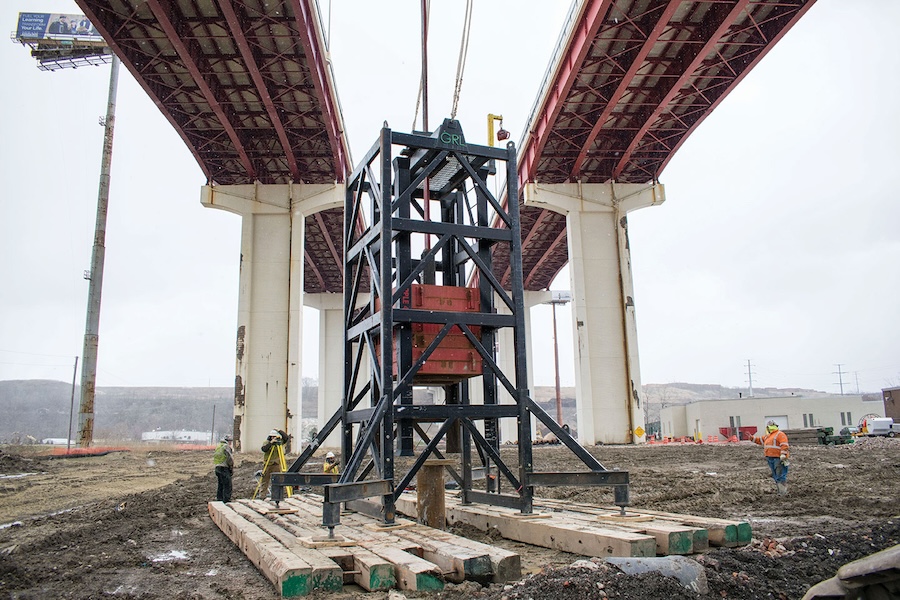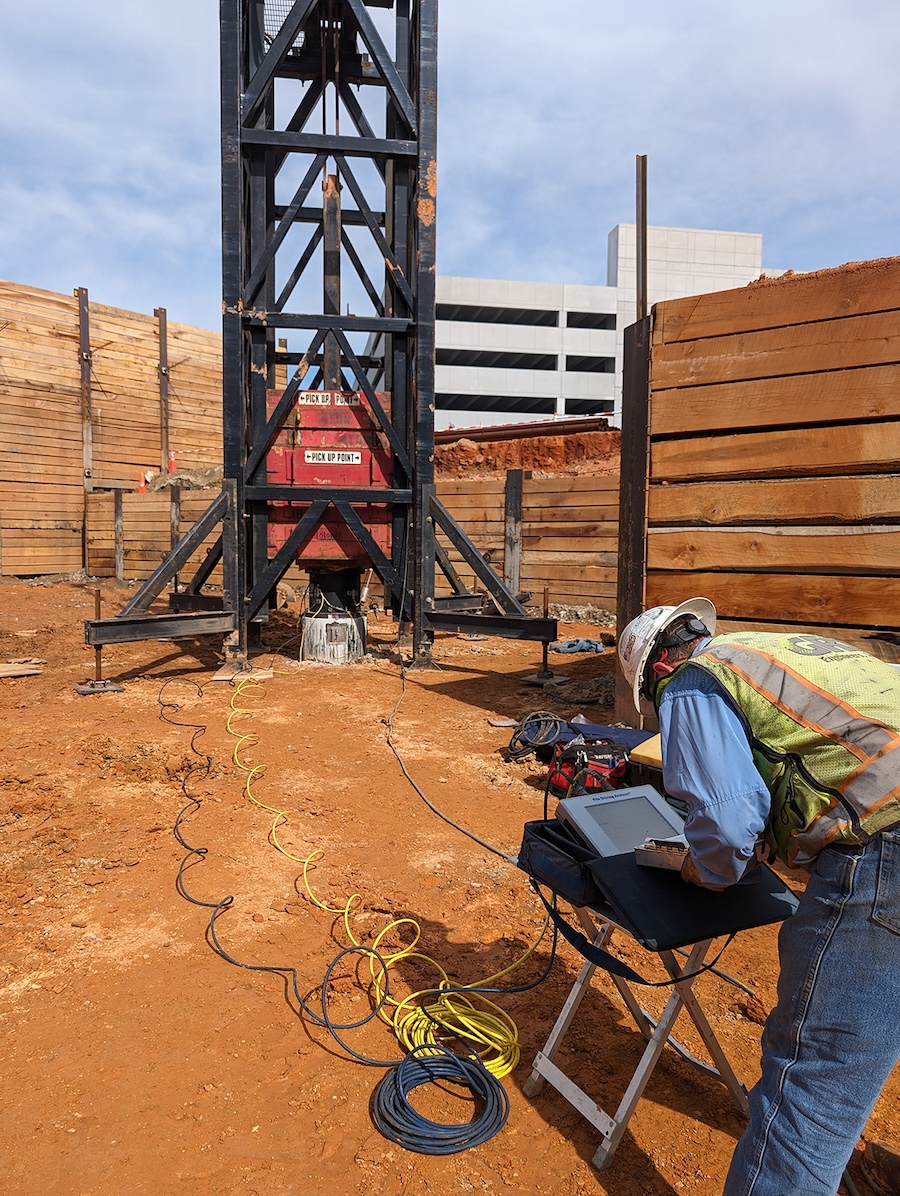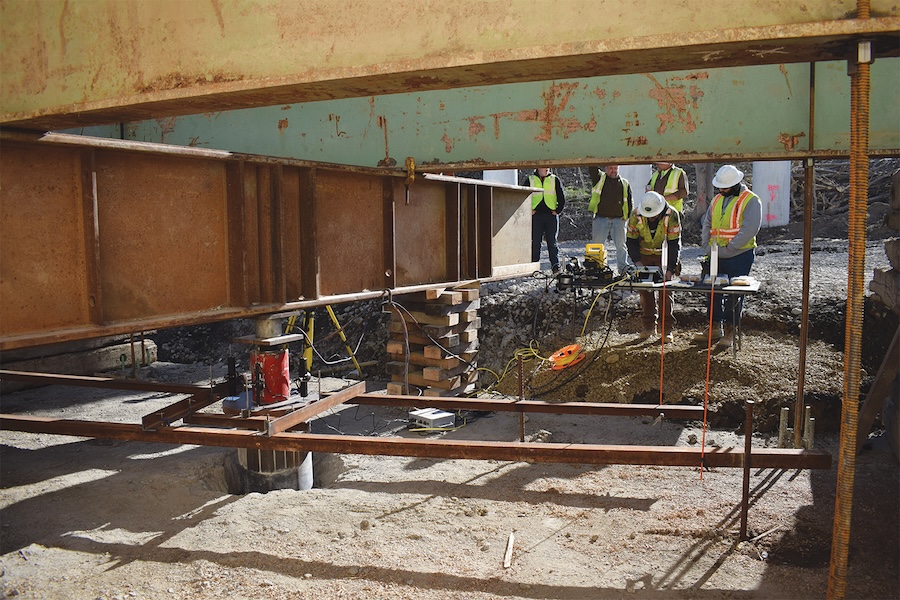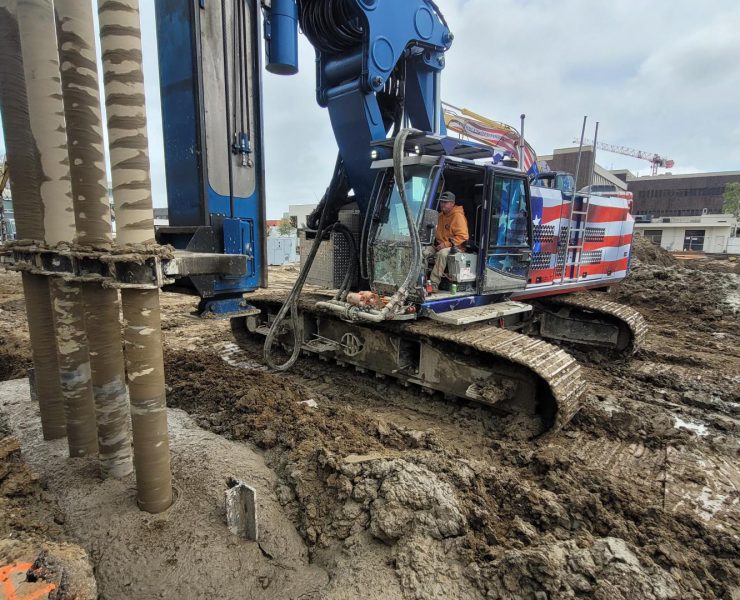Static vs. Dynamic Load Testing: Evaluating Drilled Shafts in Deep Foundation Construction


View the complete article here.
Drilled shafts, also known as drilled piers or caissons, are essential components in deep foundation construction—providing critical support by transferring structural loads to deeper, more stable soil layers or bedrock. These shafts are created by drilling a cylindrical hole into the ground and filling it with reinforced concrete—making them ideal for supporting buildings, bridges, towers, and other heavy structures due to their high load-bearing capacity and ability to withstand lateral loads.
Load testing plays a vital role in ensuring the structural integrity of drilled shafts by verifying their load-bearing capacity and detecting potential issues such as material defects, installation errors, or unexpected soil conditions. By applying a controlled load to the shaft and measuring its response, engineers can confirm the shaft’s performance—ensuring safety and durability over the structure’s intended lifespan.
Static and dynamic load testing are the two primary methods used to assess the load-bearing capacity and integrity of drilled shafts. Static load testing involves applying a slow and constant load to the shaft and measuring its response over time, providing a direct and traditional means of assessment. On the other hand, dynamic load testing applies a high-energy impact to the shaft and measures the resulting stress waves and response. This method offers faster results and is often more cost-effective, allowing multiple shafts to be tested in a short period. By comparing these two methods, engineers and contractors can select the most appropriate testing approach based on project requirements and site conditions.
Understanding Static Load Testing
Static load testing is a method used to evaluate the load-bearing capacity and behavior of deep foundations, such as drilled shafts. The test involves applying a gradually increasing load to the foundation element until it reaches a predetermined level or causes a specific amount of displacement. This method allows engineers to directly measure the load-deflection behavior of the foundation, providing critical data on its performance under various load conditions. The principles of static load testing are based on the application of loads and the measurement of corresponding displacements, which help determine the ultimate load-bearing capacity and serviceability of the foundation.
Detailed Process and Equipment Used
The static load testing process begins with the installation of the drilled shaft or other deep foundation element. Once installed, the testing equipment is set up—which typically includes a load frame, hydraulic jacks, load cells, displacement transducers, and reaction systems. The hydraulic jacks apply the load to the foundation, while the load cells measure the applied load. Displacement transducers are used to measure the movement of the foundation element in response to the applied load.
The test is conducted in several stages, starting with an initial load application—followed by incremental loading and unloading cycles. Each load increment is maintained for a specified period to allow for the measurement of creep or time-dependent displacement. The process continues until the maximum test load is reached or significant movement is observed. Data collected during the test includes load versus displacement, which is analyzed to determine the foundation’s load-bearing capacity and deformation characteristics.
Typical Applications and Scenarios for Use
Static load testing is commonly used in various construction projects where accurate and reliable data on foundation performance is required. Typical applications include the construction of high-rise buildings, bridges, industrial facilities, and other structures that require deep foundations. This method is particularly useful in scenarios where:
- High precision in load capacity determination is necessary.
- Verification of design assumptions and soil conditions is required.
- Load tests need to be performed under controlled and repeatable conditions.
- Engineers need to confirm the performance of foundations in challenging soil conditions or variable subsurface profiles.
Overall, static load testing provides a direct and reliable means of assessing the performance of deep foundations—ensuring the safety and stability of the supported structures.
 Understanding Dynamic Load Testing
Understanding Dynamic Load Testing
Dynamic load testing (DLT) is a method used to evaluate the load-bearing capacity and integrity of deep foundations, such as drilled shafts, by applying a high-energy impact to the foundation element. This impact generates stress waves that travel through the shaft and surrounding soil, which are then measured and analyzed to determine the foundation’s performance characteristics. The principles of dynamic load testing rely on the analysis of these stress waves to assess parameters such as shaft capacity, shaft integrity, and soil resistance.
Detailed Process and Equipment Used
The dynamic load testing process begins with the preparation of the drilled shaft, which includes installing necessary instrumentation like strain gauges and accelerometers. These sensors are attached to the shaft to measure the strain and acceleration generated by the impact.
The primary equipment used in dynamic load testing includes a Pile Driving Analyzer (PDA) and a hammer or drop weight to apply the impact load. The PDA is connected to the sensors and records the data from the test. The test procedure involves the following steps:
- Impact application: A hammer or drop weight is used to deliver a high-energy impact to the top of the drilled shaft.
- Data collection: The sensors capture the resulting stress waves and transmit the data to the PDA.
- Data analysis: The PDA analyzes the stress wave data in real-time—providing immediate results on the load-bearing capacity, shaft integrity, and soil resistance.
Dynamic load testing is typically faster and less intrusive than static load testing, allowing for multiple tests to be conducted in a short period.
Typical Applications and Scenarios for Use
Dynamic load testing is commonly used in construction projects where quick and efficient assessment of foundation performance is required. Typical applications include:
- Projects with tight schedules that demand rapid testing and results.
- Sites with limited access or environmental constraints where traditional static load testing may be challenging.
- Large-scale projects requiring testing of multiple shafts in a short timeframe.
- Situations where immediate feedback on foundation performance is beneficial for making real-time decisions and adjustments.
Overall, dynamic load testing provides a practical and effective means of evaluating the performance of deep foundations—offering valuable insights that help ensure the safety and stability of the supported structures.
Comparative Analysis
Static and dynamic load testing differ significantly in efficiency and speed. Static load testing is a slower process, applying gradual loads over extended periods—often taking several hours or days to complete. In contrast, dynamic load testing is much faster—typically taking just minutes per shaft, allowing multiple shafts to be tested in a single day. This efficiency makes dynamic load testing particularly advantageous for large-scale projects or situations requiring rapid assessment.
Cost considerations also play a crucial role in selecting the appropriate load testing method. Static load testing involves higher costs due to extensive equipment setup, prolonged testing duration, and labor-intensive procedures—making it a more costly option for projects with numerous shafts. Dynamic load testing, with its quicker process and less intrusive setup, tends to be more cost-effective. The reduced time and labor requirements lower overall testing expenses, providing a more economical solution without compromising data quality.
In terms of accuracy and reliability, both methods are dependable for assessing load-bearing capacity and integrity. Static load testing offers direct measurements of load versus displacement, providing detailed insights into shaft performance under continuous loads—often considered more accurate for determining ultimate load capacity. Dynamic load testing, while reliable, relies on stress wave analysis from impacts—offering quick results on shaft capacity and integrity. However, this data may require interpretation and calibration against static load test results for certain conditions.
The suitability of each method varies based on site conditions and project types. Static load testing is ideal for projects requiring precise load-displacement data, such as high-rise buildings and bridges, and is suitable for stable sites where prolonged testing is feasible. Dynamic load testing is better for sites with limited access or environmental constraints and for large-scale projects needing rapid testing of numerous shafts. The choice between methods should consider specific site conditions, project requirements, and desired outcomes to ensure optimal foundation performance and safety.
Conclusion
Static and dynamic load testing are essential for assessing the load-bearing capacity and integrity of drilled shafts. Static load testing offers detailed insights through gradual load application—while dynamic load testing provides faster, cost-effective results with high-energy impacts. Each method is suitable for different projects and site conditions, depending on the specific requirements.
Selecting the appropriate method involves considering project needs. Static load testing is ideal for precise, extended testing—while dynamic load testing is better for rapid, cost-efficient assessments with minimal site disruption. Understanding these methods helps engineers and contractors ensure the safety and stability of deep foundation projects.
View the complete article here.
What is the main difference between static and dynamic load testing for drilled shafts?
Static load testing applies a slow, constant load to measure displacement, while dynamic load testing uses high-energy impacts to measure stress waves and response.
When should dynamic load testing be preferred over static load testing?
Dynamic load testing should be preferred for projects requiring quick, cost-effective assessment and rapid testing of multiple shafts.














 Understanding Dynamic Load Testing
Understanding Dynamic Load Testing



